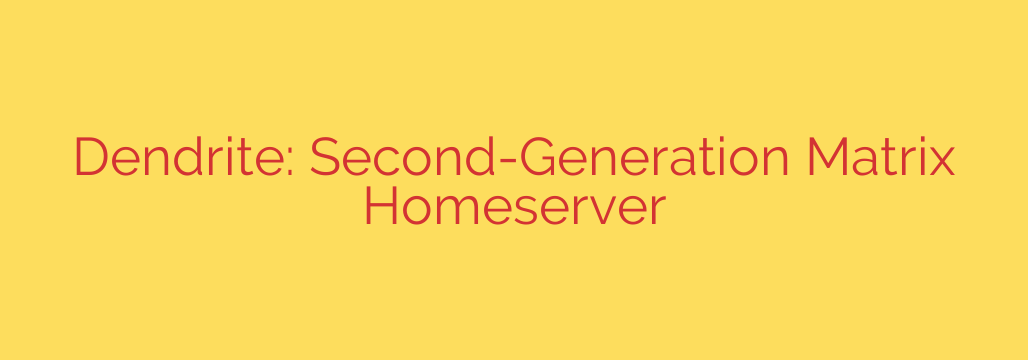
Dendrite: The High-Performance Matrix Homeserver You’ve Been Waiting For
In the world of secure, decentralized communication, the Matrix protocol has established itself as a powerful and flexible standard. For years, the go-to server implementation has been Synapse. While incredibly robust, Synapse’s resource requirements have often been a barrier for hobbyists and smaller organizations. Enter Dendrite, the next-generation Matrix homeserver designed from the ground up for efficiency, performance, and scalability.
If you’re looking for a leaner, faster, and more modern way to run your own corner of the Matrix network, Dendrite is the answer.
What Exactly is Dendrite?
Dendrite is an official second-generation Matrix homeserver developed by the Matrix.org team. Unlike its predecessor, which is written in Python, Dendrite is built using Go (Golang), a language renowned for its performance and concurrency. This fundamental difference is the key to its efficiency, allowing it to serve Matrix users with a fraction of the hardware resources typically required.
The goal of the project is simple but ambitious: to provide a Matrix server that is not only lighter and faster but also more scalable, making self-hosted, decentralized communication accessible to everyone—from Raspberry Pi enthusiasts to large-scale enterprises.
Key Advantages: Why Choose Dendrite?
Dendrite isn’t just a rewrite; it’s a complete reimagining of what a Matrix homeserver can be. Its benefits stem from its modern architecture and a clear focus on performance.
Significantly Lower Resource Footprint: This is perhaps the most compelling reason to consider Dendrite. Thanks to Go’s efficiency, Dendrite consumes far less RAM and CPU power than Synapse. This makes it an ideal choice for running on low-power devices, small virtual private servers (VPS), or shared hardware without impacting other services.
A Modern Microservice Architecture: Instead of a single, monolithic application, Dendrite is composed of multiple smaller, independent components (microservices). Each component handles a specific task, such as managing client APIs, handling federation with other servers, or processing media. This design offers several critical advantages:
- Scalability: You can scale individual components based on your specific needs. If your server handles a lot of media, you can allocate more resources just to the media component.
- Resilience: If one component fails, it doesn’t necessarily bring down the entire server. This leads to higher uptime and greater stability.
- Maintainability: Developing and updating smaller, focused components is far simpler and less error-prone.
Enhanced Performance: The combination of a compiled language like Go and a multi-component architecture results in a homeserver that feels noticeably snappier. Room joins are faster, message delivery is quicker, and the entire user experience is smoother, especially under heavy load.
Who Should Consider Using Dendrite?
While Dendrite is rapidly becoming a viable option for everyone, it is particularly well-suited for a few key groups:
- Home Lab Enthusiasts and Self-Hosters: If you want to run a Matrix server on a Raspberry Pi, a small NAS, or a budget-friendly VPS, Dendrite’s low resource usage makes it the perfect choice.
- Small to Medium-Sized Organizations: Businesses, communities, and teams that need a private, secure communication platform can deploy Dendrite without investing in expensive, dedicated server hardware.
- Developers and Peer-to-Peer Innovators: Dendrite’s architecture and performance make it an excellent platform for building next-generation P2P and decentralized applications on top of the Matrix protocol.
Getting Started & Security Best Practices
Setting up Dendrite is more straightforward than you might think, especially if you are familiar with Docker. The official documentation provides a clear path for installation and configuration.
Here is some actionable advice for a secure and stable deployment:
- Use Docker: The recommended method for running Dendrite is via Docker containers. This simplifies dependency management and isolates the application for better security.
- Generate Strong Keys: During setup, you will generate several cryptographic keys for your server. Store these keys securely and back them up, as losing them will mean losing your server’s identity.
- Place it Behind a Reverse Proxy: For security and proper operation, you must run Dendrite behind a reverse proxy like NGINX or Caddy. The reverse proxy will handle TLS/SSL termination (HTTPS), ensuring all communication to and from your server is encrypted. This is not optional; it is a critical security step.
- Configure Federation: To communicate with users on other Matrix servers (like matrix.org), you will need to configure your server for federation. This involves setting up the correct DNS records and ensuring your server is reachable by the public internet on the designated port (typically 8448).
The Future of Decentralized Communication is Here
Dendrite represents a major leap forward for the Matrix ecosystem. By lowering the barrier to entry for self-hosting, it empowers more individuals and organizations to take control of their own communications. With its superior performance, efficient resource usage, and robust, scalable architecture, Dendrite is no longer an experiment—it is a production-ready homeserver that is ready to power the next wave of the decentralized web.
Source: https://www.linuxlinks.com/dendrite-second-generation-matrix-homeserver/








